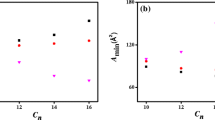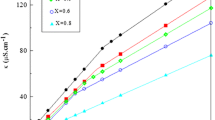Abstract
To model the binding to biomembranes, the interactions of potent N-m-tolylbenzamide (NTB) with a cationic surfactant, cetyltrimethylammonium bromide (CTAB) and an anionic surfactant, sodium dodecyl sulfate (SDS), have been investigated. The study was carried out by quantifying the absorption and fluorescence emission spectra of NTB as a function of pre-micellar to post-micellar surfactant concentrations in the temperature range of 25–50 °C. NTB is a strongly fluorescent compound that exhibits intense violet fluorescence. Using mathematical models, the water–micelle partition coefficient (K x), surfactant–NTB binding constant (K b), binding capacity (n b) and the degree of counter-ion binding (α) are discussed from the thermodynamic viewpoint, considering the thermodynamic parameters of additive solubilization (\( \Delta G_{\text{p}}^{^\circ } ,\,\Delta H_{\text{p}}^{^\circ } ,\,\Delta S_{\text{p}}^{^\circ } \)). The high values of all interactions, especially when the surface charge of the organized medium is cationic, ensure that there are greater interactions between the NTB and CTAB than with SDS. The NTB molecule is found to be located at only one binding site of each surfactant and probably exhibits static quenching rather than a collisional quenching mechanism. These findings have been confirmed by the binding capacity for the NTB–surfactant combinational system and Stern–Volmer quenching constant (K sv) values. The observed depression in binding strength of the counterions with temperature increase favors the promising solubilization of NTB in the palisade layer of micelles leading to penetration binding.










Similar content being viewed by others
References
Schott, H.: Colloidal Dispersion. In Remington: The Science and Practice of Pharmacy. Lippincott Williams and Wilkins (2000)
Nairn, J.G.: Solutions, Emulsions, Suspensions and Extracts. In Remington: The Science and Practice of Pharmacy. Lippincott Williams and Wilkins (2000)
Nazar, M.F., Khan, A.M., Shah, S.S.: Microemulsion system with improved loading of piroxicam: a study of microstructure. AAPS Pharm. Sci. Tech. 10, 1286–1294 (2009)
Kizilbash, N.A., Asif, S., Nazar, M.F., Shah, S.S., Alenizi, D.: Design of a microemulsion based drug delivery system for diclofenac sodium. J. Chem. Soc. Pak. 33, 1–6 (2011)
Din, K., Rub, M.A., Naqvi, A.Z.: Micellization of mixtures of amphiphilic drugs and cationic surfactants: a detailed study. Colloids Surf. B 92, 16–24 (2012)
Badshah, A., Nawaz, S., Nazar, M.F., Shah, S.S., Hasan, A.: Synthesis of novel fluorescent cyclohexenone derivatives and their partitioning study in ionic micellar media. J. Fluoresc. 20, 1049–1059 (2010)
Rosen, M.J., Kunjappu, J.T.: Surfactants and Interfacial Phenomena, 4th edn, pp. 202–234. John Willey and Sons Inc., Hoboken (2012)
Nazar, M.F., Shah, S.S., Khosa, M.A.: Interaction of azo dye with cationic surfactant under different pH conditions. J. Surf. Deterg. 13, 529–537 (2010)
Khosa, M.A., Shah, S.S., Nazar, M.F.: UV–Visible spectrometric study and micellar enhanced ultrafiltration of alizarin red s dye. J. Disper. Sci. Tech. 32, 1634–1640 (2011)
Krauel, K., Davies, N.M., Hook, S., Rades, T.: Using different structure types of microemulsions for the preparation of poly(alkylcyanoacrylate) nanoparticles by interfacial polymerization. J. Control Release 106, 76–87 (2005)
Tong, S.W., Xiang, B., Dong, D.W., Qi, X.R.: Enhanced antitumor efficacy and decreased toxicity by self-associated docetaxel in phospholipid-based micelles. Int. J. Pharm. 434, 413–419 (2012)
Rodrigues, C., Gameiro, P., Reis, S., Lima, J., de Castro, B.: Interaction of grepafloxacin with large unilamellar liposomes: partition and fluorescence studies reveal the importance of charge interactions. Langmuir 18, 10231–10236 (2002)
Schreier, S., Malheiros, S.V.P., de Paula, E.: Surface active drugs: self-association and interaction with membranes and surfactants, physicochemical and biological aspects. Biochim. Biophys. Acta 1508, 210–234 (2000)
Kim, E.J., Shah, D.O.: Cloud point phenomenon in amphiphilic drug solutions. Langmuir 18, 10105–10108 (2002)
Saeed, A., Irfan, M., Bolte, M.: 4-Chloro-N-m-tolyl-benzamide. Acta Cryst. E65, o1334 (2009)
Saeed, A., Hussain, S., Flörke, U.: The crystal structure of 2-nitro-N-(4-nitrophenyl)benzamide. Turk. J. Chem. 32, 481–486 (2008)
Olsson, A.R., Lindgren, H., Pero, R.W., Leanderson, T.: Mechanism of action for N-substituted benzamide-induced apoptosis. Br. J. Cancer 86, 971–978 (2002)
Zhang, Q.W., Li, J.Q.: Synthesis and biological evaluation of N-(aminopyridine) benzamide analogues as histone deacetylase inhibitors. Bull. Korean Chem. Soc. 33, 535–540 (2012)
Xu, J., Lecanu, L., Tan, M., Yao, W., Greeson, J., Papadopoulos, V.: The benzamide derivative N-[1-(7-tert-butyl-1H-indol-3-ylmethyl)-2-(4-cyclopropanecarbonyl-3 methyl piperazin-1-yl)-2-oxo-ethyl]-4-nitro-benzamide (SP-10) reduces HIV-1 infectivity in vitro by modifying actin dynamics. Antivir. Chem. Chemother. 17, 331–342 (2006)
Lindgren, H., Pero, R.W., Ivars, F., Leanderson, T.: N-substituted benzamides inhibit nuclear factor-kappa B and nuclear factor of activated T cells activity while inducing activator protein 1 activity in T lymphocytes. Mol. Immunol. 38, 267–277 (2001)
Saeed, A., Zaman, S., Bolte, M.: N-(2-Chloro-4-nitrophenyl)-2-nitrobenzamide. Acta Cryst. E64, 0705 (2008)
William, B., Christopher, W., Niklas, P.: 4-(Phenyl-piperazinyl-methyl)benzamide derivatives and their use for the treatment of pain, anxiety or gastrointestinal disorders. U.S. Patent No. 8022074 (2011)
Eisenhut, M., Hull, W.E., Mohammed, A., Mier, W., Lay, D., Just, W., Gorgas, K., Lehmann, W.D., Haberkorn, U.: Radioiodinated N-(2-diethylaminoethyl)benzamide derivatives with high melanoma uptake: structure-affinity relationships, metabolic fate, and intracellular localization. J. Med. Chem. 43, 3913–3922 (2000)
Jin, R., Zhang, J.: Theoretical investigation of chemosensor for fluoride anion based on amidophthalimide derivatives. Theor. Chim. Acta 124, 225–234 (2009)
Hiroyuki, I., Kaoru, K., Shinichi, M., Takeo, M., Norimasa, Y.: Benzamide derivatives and plant growth regulants containing them. U.S. Patent No. 5043006 (1991)
Marquezin, C.A., Hirata, I.Y., Juliano, L., Ito, A.S.: Spectroscopic characterization of 2-amino-N-hexadecyl-benzamide (AHBA), a new fluorescence probe for membranes. Biophys. Chem. 124, 125–133 (2006)
Raheel, M., Shah, S.S., Khosa, M.A.: Thermodynamics of surfactant micellization in presence of benzamide derivatives. J. Disper. Sci. Tech. 32, 507–511 (2011)
Kawamura, H., Manabe, M., Miyamoto, Y., Fujita, Y., Tokunaga, S.: Partition coefficient of homologous-omega-phenylalkanols between water and sodium dodecyl sulfate micelles. J. Phys. Chem. 93, 5536–5540 (1989)
Castellan, G.W.: Physical Chemistry. Benjamin/Cummings Publishing Company, California (1983)
Tunç, S., Duman, O., Kancı, B.: Spectrophotometric investigation of the interactions between cationic dye (C.I. Basic Yellow 2) and anionic surfactant (sodium dioctylsulfosuccinate) in the premicellar and micellar region. Dyes Pigments 94, 233–238 (2012)
Nazar, M.F., Khan, A.M., Shah, S.S.: Interaction of azo dye with cationic surfactant under different pH conditions. J. Disper. Sci. Tech. 31, 596–605 (2010)
Kadam, Y., Yerramilli, U., Bahadur, A.: Solubilization of poorly water-soluble drug carbamazepine in pluronic micelles: effect of molecular characteristics, temperature and added salt on the solubilising capacity. Colloids Surf. B 72, 141–147 (2009)
Krishna, A.K., Flanagan, D.R.: Micellar solubilization of a new antimalarial drug, β-arteether. J. Pharm. Sci. 78, 574–576 (1989)
Leibner, J.E., Jacobus, J.: Charged micelle shape and size. J. Phys. Chem. 81, 130–135 (1977)
Khamis, M., Bulos, B.: Azo dyes interactions with surfactants. Determination of the critical micelle concentration from acid–base equilibrium. Dyes Pigments 66, 179–183 (2005)
Buwalda, R.T., Jonker, J.M., Engberts, J.B.F.N.: Aggregation of azo dyes with cationic amphiphils at low concentrations in aqueous solutions. Langmuir 15, 1083–1089 (1999)
Miyashita, Y., Hayano, S.: Kinetic study of the penetration of an anthraquinoid acidic dye into cationic micelles. Bull. Chem. Soc. Jpn 54, 3249–3252 (1981)
Wang, L., Verrall, R.E.: Apparent molar volume and apparent molar adiabatic compressibility studies of anesthetic molecules in aqueous micelle solutions of CTAB and CTAC as a function of surfactant concentration and temperature. J. Phys. Chem. 98, 4368–4374 (1994)
Kang, J., Liu, Y., Xie, M.X., Li, S., Jiang, M., Wang, Y.D.: Interactions of human serum albumin with chlorogenic acid and ferulic acid. Biochim. Biophys. Acta 1674, 205–214 (2004)
Techen, A., Hille, C., Dosche, C., Kumke, M.U.: Fluorescence study of drug–carrier interactions in CTAB/PBS buffer model systems. J. Colloid Interface Sci. 377, 251–261 (2012)
Zhou, T., Ao, M., Xu, G., Liu, T., Zhang, J.: Interactions of bovine serum albumin with cationic imidazolium and quaternary ammonium gemini surfactants: effects of surfactant architecture. J. Colloid Interface Sci. 389, 175–181 (2013)
Ahmad, B., Parveen, S., Khan, R.H.: Effect of albumin conformation on the binding of ciprofloxacin to human serum albumin: a novel approach directly assigning binding site. Biomacromolecules 7, 1350–1356 (2006)
Acknowledgments
Authors express gratitude to the Department of Chemistry, Quaid-i-Azam University, Islamabad, Pakistan for provision of lab facility and gratefully acknowledge the Higher Education Commission of Pakistan for sponsorship.
Author information
Authors and Affiliations
Corresponding author
Rights and permissions
About this article
Cite this article
Nazar, M.F., Raheel, M., Shah, S.S. et al. Thermodynamic Characteristics and Spectral-Luminescent Properties of N-m-Tolylbenzamide in Microheterogeneous Surfactant Self-Assemblies. J Solution Chem 43, 632–647 (2014). https://doi.org/10.1007/s10953-014-0151-x
Received:
Accepted:
Published:
Issue Date:
DOI: https://doi.org/10.1007/s10953-014-0151-x




